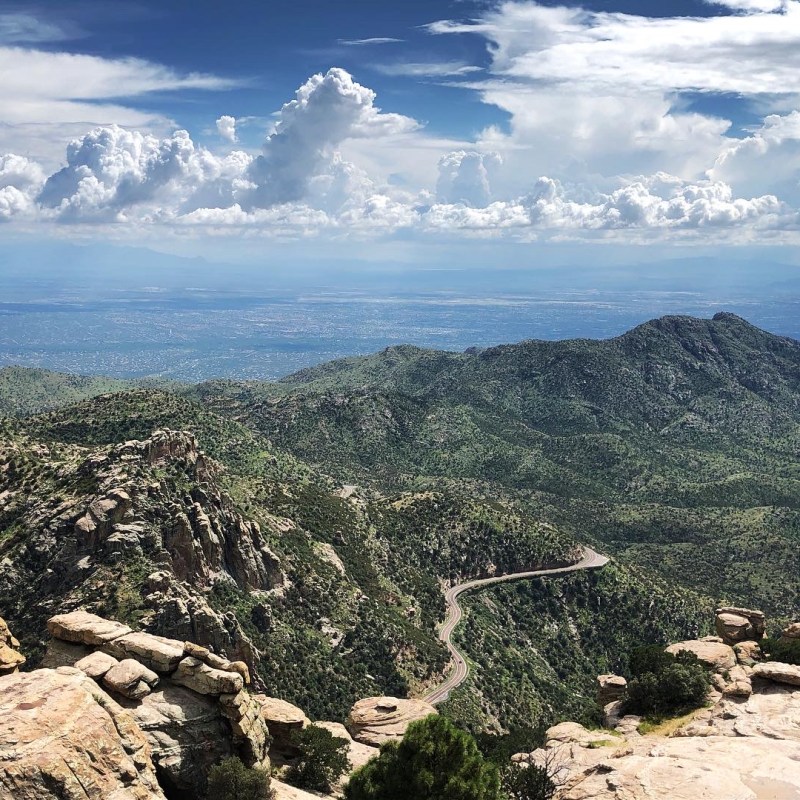
Cool mountain breezes replace hot desert gusts, and cactus-covered valleys become a distant blur as you climb higher and higher into the Southwestern-U.S. mountain ranges known as “Sky Islands.”
Videos by TravelAwaits
From my experiences exploring Sky Islands in Arizona, Texas, and New Mexico, the high-elevation regions offer a wonderful break from what can be brutal desert surroundings, especially during the hot summer months.
The U.S. Forest Service defines Sky Islands as isolated mountain ranges that rise from a surrounding desert floor near the southern border of the United States. Because of the dramatic changes in elevation — climbing in some instances from the 2,000-foot range in the desert to as high as 9,000 feet or more in the mountains — the Sky Islands strike a dramatic contrast to the arid terrain, plants, and animals of regions like the Sonoran Desert and the Chihuahuan Desert.
A Forest Service explanation of the phenomenon notes that the plants and animals living in the mountains would not be able to survive in the surrounding deserts. “Thus, by analogy, the mountains are ‘islands’ surrounded by deserts that are the ‘seas,’” it says.
I find the Sky Island concept a fascinating way to look at the deserts and mountains of the Southwestern states. There is something especially gratifying about driving the steep, twisting roads into the Sky Islands, leaving the desert heat behind, and emerging into pine-scented air that might be 30 degrees cooler.
Here are seven amazing Sky Islands to visit in Arizona, Texas, and New Mexico.

(Photo Credit: Cindy Barks)
1. Catalina Mountains
Arizona
One of Arizona’s most beloved Sky Islands sits less than 30 miles from the busy streets of the desert city of Tucson. The Santa Catalina Mountains (also known as the Catalinas) rise from the Sonoran Desert and loom over Tucson to the north and northeast.
There are a number of ways to access the Catalinas, but one of my favorites is to take the highway known as the Mt. Lemmon Sky Island Scenic Byway from the northeastern corner of Tucson to the charming little mountain town of Summerhaven.
The highway meanders northerly through the Mount Lemmon area, traversing 27 miles and climbing more than 6,000 feet. Also called the Mt. Lemmon Highway or the Catalina Highway Scenic Drive, the byway starts in the midst of some of the state’s most beautiful desert terrain and climbs steeply through areas of rocky hoodoos, finally emerging in the lush pine-tree-and-wildflower environment of Summerhaven.
Pro Tip: Another way to experience the Catalinas is to visit the beautiful Catalina State Park, which sits at the base of the mountain range and offers amazing views of the rugged peaks. The park is also known for its desert plant life and features nearly 5,000 saguaros. It offers a range of desert and mountain hiking opportunities.

(Photo Credit: Cindy Barks)
2. Santa Rita Mountains
Arizona
For another Arizona mountain range with the Sky Island distinction, head about an hour southeast of Tucson to the Santa Rita Mountains in the Coronado National Forest. The Santa Ritas are adjacent to the rugged Patagonia Mountains, which run near the U.S./Mexico border east of Nogales, Arizona.
The Santa Ritas top out at nearly 9,500 feet elevation, compared with Tucson’s 2,400 feet. The highest point is Mount Wrightson with an elevation of 9,453 feet. The range is among the Madrean Sky Islands of southeastern Arizona, southwestern New Mexico, and northwestern Mexico — known for their pine-oak forests and tropical and subtropical coniferous forests.
About 20 miles southeast of Tucson on Interstate 10, Highway 83 (later Highway 82) heads south along the Sonoita-Patagonia Scenic Road. The route begins in desert terrain bursting with spiny ocotillos before beginning a steep climb through rolling terrain and golden grasslands — all with jagged mountain peaks as a backdrop.
Pro Tip: Along with its scenic mountains and canyons, the Santa Rita Mountain region is also famous for the nearby wine country in Sonoita and Elgin, as well as the charming little enclave of Patagonia, known for its colorful downtown, its stellar bird watching, and its desert hiking along the southern terminus of the 800-mile Arizona Trail.

(Photo Credit: Cindy Barks)
3. Chiricahua Mountains
Arizona
The Chiricahua Mountains rise in the far southeastern corner of Arizona in a mass of rock hoodoos, jagged cliffs, gnarly trees, and dusty bluffs. The mountain range, one of the state’s distinctive Sky Islands, is memorialized at the Chiricahua National Monument.
Billed as a “Wonderland of Rocks,” the national monument features an 8-mile paved scenic drive and 17 miles of trails that take hikers right into the midst of stands of hoodoos, the thin spires of rock that make the region stand out.
The Chiricahua National Monument Visitor Center sits at 5,400 feet above sea level, and the mountains’ high point, Chiricahua Peak, is at 9,795 feet. The monument’s scenic drive winds through the area and ends at Maasai Point, at nearly 7,000 feet elevation.
Pro Tip: The Chiricahua National Monument is about an hour and 15 minutes from the Old West town of Tombstone, home of the infamous 1881 shootout at the O.K. Corral. The two destinations make for great stops on a southern Arizona road trip. Learn more about the best things to do in historic Tombstone here.

(Photo Credit: Cindy Barks)
4. Guadalupe Mountains
Texas
Four of the five highest peaks in Texas are clustered in the Guadalupe Mountains, a range of mountains that rise from the Chihuahuan Desert, creating a high-altitude island about 115 miles east of the West Texas city of El Paso.
Right in the heart of the mountain range is Guadalupe Mountains National Park, which is made up of about 86,400 acres located just south of the New Mexico border. The mountains loom more than 3,000 feet above the arid Chihuahuan Desert that surrounds them. Guadalupe Peak, 8,751 feet above sea level, is the highest point in Texas.
Driving east from the desert city of El Paso, you will begin to encounter a steep climb as the land transitions to Sky Island terrain. On my June 2021 road trip through West Texas, I was pleasantly surprised when I arrived at the Guadalupe Mountains National Park to find cool, misty weather in the 60-degree range. The cooler climate is perfect for checking out the national park’s many excellent hiking trails, including the one to the summit of Guadalupe Peak, known as the “Top of Texas” for its 8,751-foot elevation.
Pro Tip: For a range of fascinating hotels in the region, check out 6 Incredible Historic Hotels In Texas Big Bend Country. Or, for El Paso’s variety of cool accommodations, see 5 Unique Stays In El Paso, Texas.

(Photo Credit: Cindy Barks)
5. Chisos Mountains
Texas
The Chisos Mountains are visible from miles around as you approach Big Bend National Park in southwest Texas. The craggy mountains, which reach an elevation of 7,825 at their highest point at Emory Peak, stand out beautifully from the surrounding Chihuahuan Desert terrain that is in the 4,000-foot elevation range.
Big Bend National Park features three main districts — the Chisos Mountains, the Rio Grande River, and the Chihuahuan Desert. The Chihuahuan Desert covers about 80 percent of the park, and it surrounds the Chisos Mountains.
The park is described as “splendid isolation,” and the Chisos range epitomizes that image with its dramatic gorges and rocky spires. Rugged hikes such as the Lost Mine Trail and Emory Peak provide access to the West Texas Sky Island.
Pro Tip: Iconic hikes are available in each of the park’s distinctive districts. For some of the best, see 11 Best Hikes in Big Bend National Park.

(Photo Credit: Cindy Barks)
6. Davis Mountains
Texas
Rising to nearly 8,400 feet from the scrubby flatlands of West Texas, the Davis Mountains offer a dramatic backdrop for quirky little towns like Marfa and Fort Davis.
The mountain range is huge, and one of the best ways to take it in is by visiting the beautiful Davis Mountains State Park, which is known for its great hiking, camping, and scenic drives.
While much of the remaining land in the Davis Mountains is private ranchland, The Nature Conservancy has preserved thousands of acres of land at the Davis Mountains Preserve. The preserve’s website explains that the Davis Mountains were formed by volcanoes and sculpted by wind and water. It adds that while the area west of the Pecos River is a true desert habitat, “the Davis Mountains are temperate and forested — an anomaly in an arid land.”
Pro Tip: The public is invited to visit the preserve on select days, and information is available on The Davis Preserve website.

(Photo Credit: Cindy Barks)
7. Sacramento Mountains
New Mexico
In a mere 20 miles or so on U.S. Highway 82 in southern New Mexico, the terrain rises from about 4,300 feet elevation in the desert town of Alamogordo to about 8,700 feet in the village of Cloudcroft, the charming little town high in the Sacramento Mountains.
The contrast between the two communities could hardly be more striking. Not far from Alamogordo is the stunning White Sands National Park, a desert region made up almost exclusively of fine white sand. Just up the road in Cloudcroft, pine and fir trees crowd steep mountain ridges.
Owing to its perch high in the sky, Cloudcroft enjoys temperatures that can be 20 to 30 degrees cooler than its lower-elevation neighbors. At White Sands, high temperatures range in the high 90s in June, July, and August, while in Cloudcroft, about 4,400 feet higher, summer highs average in the 70s, and nights get down into the cool 40s.
Pro Tip: Cloudcroft is the home of the historic Cloud-Climbing Trestle Trail (also known as the Mexican Canyon Trestle), which makes for a fascinating hike in the Lincoln National Forest.
